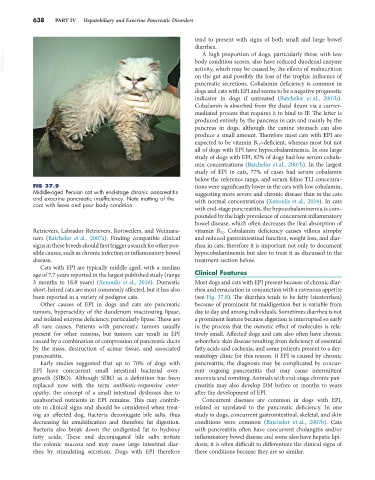Page 666 - Small Animal Internal Medicine, 6th Edition
P. 666
638 PART IV Hepatobiliary and Exocrine Pancreatic Disorders
tend to present with signs of both small and large bowel
diarrhea.
VetBooks.ir body condition scores, also have reduced duodenal enzyme
A high proportion of dogs, particularly those with low
activity, which may be caused by the effects of malnutrition
on the gut and possibly the loss of the trophic influence of
pancreatic secretions. Cobalamin deficiency is common in
dogs and cats with EPI and seems to be a negative prognostic
indicator in dogs if untreated (Batchelor et al., 2007b).
Cobalamin is absorbed from the distal ileum via a carrier-
mediated process that requires it to bind to IF. The latter is
produced entirely by the pancreas in cats and mainly by the
pancreas in dogs, although the canine stomach can also
produce a small amount. Therefore most cats with EPI are
expected to be vitamin B 12 –deficient, whereas most but not
all of dogs with EPI have hypocobalaminemia. In one large
study of dogs with EPI, 82% of dogs had low serum cobala-
min concentrations (Batchelor et al., 2007b). In the largest
study of EPI in cats, 77% of cases had serum cobalamin
below the reference range, and serum feline TLI concentra-
FIG 37.9 tions were significantly lower in the cats with low cobalamin,
Middle-aged Persian cat with end-stage chronic pancreatitis suggesting more severe and chronic disease than in the cats
and exocrine pancreatic insufficiency. Note matting of the with normal concentrations (Xenoulis et al., 2016). In cats
coat with feces and poor body condition.
with end-stage pancreatitis, the hypocobalaminemia is com-
pounded by the high prevalence of concurrent inflammatory
bowel disease, which often decreases the ileal absorption of
Retrievers, Labrador Retrievers, Rottweilers, and Weimara- vitamin B 12 . Cobalamin deficiency causes villous atrophy
ners (Batchelor et al., 2007a). Finding compatible clinical and reduced gastrointestinal function, weight loss, and diar-
signs in these breeds should first trigger a search for other pos- rhea in cats; therefore it is important not only to document
sible causes, such as chronic infection or inflammatory bowel hypocobalaminemia but also to treat it as discussed in the
disease. treatment section below.
Cats with EPI are typically middle aged, with a median
age of 7.7 years reported in the largest published study (range Clinical Features
3 months to 18.8 years) (Xenoulis et al., 2016). Domestic Most dogs and cats with EPI present because of chronic diar-
short-haired cats are most commonly affected, but it has also rhea and emaciation in conjunction with a ravenous appetite
been reported in a variety of pedigree cats. (see Fig. 37.8). The diarrhea tends to be fatty (steatorrhea)
Other causes of EPI in dogs and cats are pancreatic because of prominent fat maldigestion but is variable from
tumors, hyperacidity of the duodenum inactivating lipase, day to day and among individuals. Sometimes diarrhea is not
and isolated enzyme deficiency, particularly lipase. These are a prominent feature because digestion is interrupted so early
all rare causes. Patients with pancreatic tumors usually in the process that the osmotic effect of molecules is rela-
present for other reasons, but tumors can result in EPI tively small. Affected dogs and cats also often have chronic
caused by a combination of compression of pancreatic ducts seborrheic skin disease resulting from deficiency of essential
by the mass, destruction of acinar tissue, and associated fatty acids and cachexia, and some patients present to a der-
pancreatitis. matology clinic for this reason. If EPI is caused by chronic
Early studies suggested that up to 70% of dogs with pancreatitis, the diagnosis may be complicated by concur-
EPI have concurrent small intestinal bacterial over- rent ongoing pancreatitis that may cause intermittent
growth (SIBO). Although SIBO as a definition has been anorexia and vomiting. Animals with end-stage chronic pan-
replaced now with the term antibiotic-responsive enter- creatitis may also develop DM before or months to years
opathy, the concept of a small intestinal dysbiosis due to after the development of EPI.
unabsorbed nutrients in EPI remains. This may contrib- Concurrent diseases are common in dogs with EPI,
ute to clinical signs and should be considered when treat- related or unrelated to the pancreatic deficiency. In one
ing an affected dog. Bacteria deconjugate bile salts, thus study in dogs, concurrent gastrointestinal, skeletal, and skin
decreasing fat emulsification and therefore fat digestion. conditions were common (Batchelor et al., 2007b). Cats
Bacteria also break down the undigested fat to hydroxy with pancreatitis often have concurrent cholangitis and/or
fatty acids. These and deconjugated bile salts irritate inflammatory bowel disease and some also have hepatic lipi-
the colonic mucosa and may cause large intestinal diar- dosis; it is often difficult to differentiate the clinical signs of
rhea by stimulating secretion. Dogs with EPI therefore these conditions because they are so similar.

